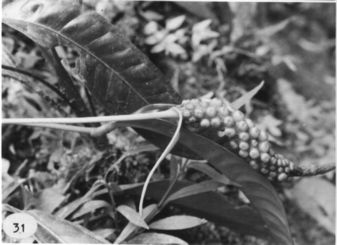




Anthurium caloveboranum Croat, sp. nov.
TYPE: Panama. Veraguas: along trail between Escuela Agricola Alto Piedra (above Santa Fe) and Río dos Bocas, ca. 10 km from the agricultural school, 530-620 m, Croat 25900 (MO 2276325, holotype; GH, isotype).
Planta epiphytica; cataphyllum membranaceum; petiolus late sulcatus ad adaxialis camplanatus, (8-) 15-24 cm longus; lamina subcoriacea, oblongo-elliptica, basi acuta, 17-29 cm longa, 4-6 cm lata, pagina inferiore glanduloso-punctata; inflorescentia lamina folius breviora; pedunculus 13-28 cm longus; spatha modice membranacea, viridis aut viridis tincta rubra aut alba, lanceolata, 2.2-6 cm longa, 5-13 mm lata; spadix viridis, 7-9 cm longus; baccae globosae, rubrae, apici depressae.
Epiphyte; stems less than 15 cm long, ca. 1 cm diam.; leaf scars obscured by cataphylls; roots slender, numerous, descending; cataphylls thin, 2.5-3.5 cm long, acuminate at apex, drying reddish brown, weathering to fine fibers.
LEAVES semierect; petioles (8-) 15-24 cm long, ca. 5 mm diam., broadly sulcate to flattened adaxially (often drying sharply triangular); geniculum terete, 0.5-1 cm long; blades moderately thick, oblong-elliptic, gradually acuminate at apex, acute at base, 17-29 cm long, 4-6 cm wide, broadest at middle or just below; upper surface semiglossy; dark glandular-punctate and paler below; midrib obtusely raised above, raised below (dry); primary lateral veins 7-10 per side, departing midrib at 35-40° angle; weakly sunken above, prominu-lous below; interprimary veins (dry) scarcely less prominent than primary lateral veins; submar-ginal collective veins arising from the base, 3-6 mm from the margin, sunken above, raised below.
INFLORESCENCE shorter than leaves; peduncle 13-28 cm long, 2-4 mm diam., equalling or longer than petioles; spathe moderately thin, greenish or green tinged with red or whitish, lanceolate, 2.2-6 cm long, 5-13 mm wide, acuminate at apex, acute at base, inserted at 45° angle on peduncle; spadix green, 7-9 cm long, 4-5 mm diam. near base, 2-3 mm diam. near apex; flowers rhombic to 4-lobed, 3.4-3.6 mm long, 1.8-2.2 mm wide, the sides jaggedly sigmoid, 4÷5 flowers visible in the principal spiral, 3-4 flowers visible in the alternate spiral; tepals matte (dry), lateral tepals ca. 2.8 mm wide, the inner margin broadly rounded; pistils not raised, green; stigmas linear, ca. 0.2 mm long; stamens retracted after anthesis.
INFRUCTESCENCE with berries globose, red, 4÷5 mm diam., depressed at apex; seeds 3-11, ovate-ellipsoid to rarely elliptic, tan, slightly flattened, 2-2.3 mm long, 1-1.8 mm wide, 0.8-1 mm thick. Fig. 31.
Anthurium caloveboranum is endemic to western Panama in tropical wet or premontane rain forest at 200 to 1,200 m.
The species is a member of section Porphyrochitonium and is distinguished by its lanceolate-elliptic to oblong, gradually long-acuminate blades that dry grayish green to grayish brown and lack glandular punctations on the upper surface. Other features include a subterete petiole, the generally elongate, slightly tapered, green spadix, and red berries that are depressed at the apex at maturity.
It is most similar to Anthurium pageanum, which has similar berries. Anthurium pageanum diners in having a sharply three-sided petiole with a generally undulate, sharp margin on the geniculum and in having glandular punctations on the upper blade surface.
The number of seeds produced per berry is variable. Croat 25636 has berries with three to five seeds, whereas Croat 25900 (the type) has eight to 11 seeds per berry.

Bocas del Toro: along Chiriquí Province border near Continental Divide,
Carretera del Oleoducto, ca. 1 km N ofQuebrada Arena, Knapp 5079
(K, MO, PMA).
Chiriquí: Continental Divide above Quebrada Arena, Knapp & Vodicka
5675 (MO).
CoclŽ: above El Petroso sawmill at Continental Divide, N of El Copé,
Sytsma & Andersson 4607 (MO).
Veraguas: Río Concepcion to Río Ban-era, Hammel 5161, 5171 (MO);
trail from Coquilo Mine to Rto Barrera junction with Río Concepcion,
Hammel 5218 (MO);
headwaters of Río Caloveborita, ca. 15 km below Escuela Agricola Alto
Piedra, above Santa Fe, Syts-ma & Andersson 4766, 4767, 477]
(MO); road between Escuela Agricola Alto Piedra & Río dos Bocas, Croat
25900 (GH, MO), Mori & Kallunki 3109 (MO);
11 km beyond Santa Fe, Croat 25624. 25636 (MO),